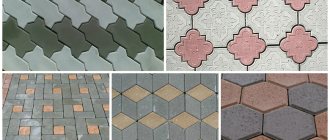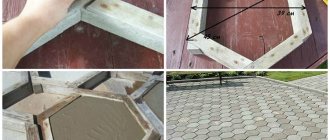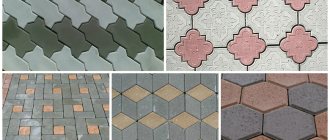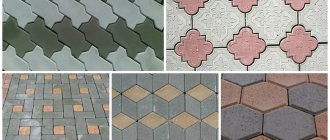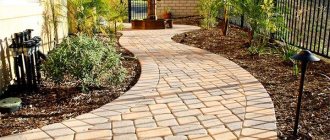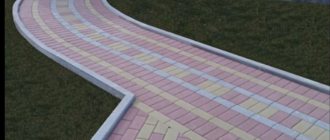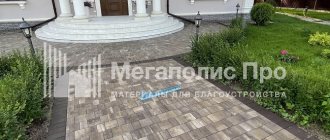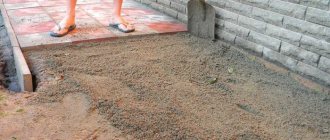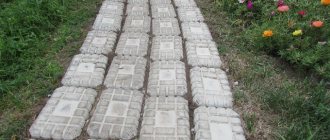0 3218
The look of the house will not be complete without proper arrangement of the site, paths, paths or parking lot. In addition to asphalt or concrete pavement, there is a more attractive and modern installation method - paving stones. Due to the variety of paving slabs, some find it difficult to choose the right type to decorate their site. In order not to get confused, you need to familiarize yourself with the features of each type.
Clinker tiles - respectability plus durability
Clinker varieties of paving slabs are the hardest of all known on the market. They are made from clinker - ceramics made from special types of clay, the high strength of which is achieved by firing at temperatures above 1200 degrees C. This is a fairly expensive material. Noble appearance, impact resistance, low water absorption are the main advantages of the product. Clinker has an anti-slip effect, which ensures strong adhesion of shoes to the surface even in rain.
Clinker tiles.
Shapes, colors and textures of clinker tiles
Photo gallery
In our photo gallery you can see 37 more ways to lay paving slabs in the photo.
Rubber tiles - safety and low cost
Rubber paving is flexible, cheap, and safe to use. It is suitable for decorating children's playgrounds and areas where people engage in physical education and sports. The product is made from crumb rubber with a fraction of 0.6 to 3 mm. According to pressing technology, it is divided into hot-pressed and cold-pressed.
Differences between rubber tiles based on manufacturing technology
Hot pressed rubber tiles
Such tiles are made from rubber crumb of a coarse fraction of 1–3 mm. During production, the molten rubber mass is poured into metal molds, where it is gradually cooled. Hot-pressed tiles are distinguished by precise geometric shapes, they are easy to lay on the ground, adjustable in size, and you can lay out interesting designs.
Hot pressed rubber tiles.
Cold pressed rubber tiles
This material is denser and is made from fine rubber crumbs with a fraction of 0.6–1 mm. Increased rubber density results in heavier weight and less ductility. However, the cost of cold-pressed tiles is higher than hot-pressed products, although the geometry is not as precise.
Cold pressed rubber tiles.
Rubber tiles in the form of squares.
Rubber tile in the form of a puzzle.
Single and double layer rubber tiles
Depending on the number of layers, rubber tiles can be single-layer or two-layer. Single-layer is a monolithic plate 1–4 cm thick, homogeneous in composition, equally colored throughout its entire depth. The two-layer one consists of a black base layer and a tinted top layer.
Double layer rubber tile.
The shapes and colors of rubber tiles are not very diverse.
Types of manufacturing technology
Types of paving slabs differ in production methods and materials used:
- With rubber filling;
- Clinker type;
- With luminous elements;
- Concrete tiles made by vibration casting;
- Polymer-sand;
- Made from natural stone;
- Hyper-pressed;
- Made of concrete, made by vibrocompression.
Vibrating tiles
To create this type of paving stones, a vibrating table, a concrete mixer, and a pressing set for molds are used. The work on creating paving slabs is carried out as follows:
- A cement mixture is mixed, including concrete, fine crushed stone, water, sand, plasticizer and coloring pigment;
- Silicone, plastic or polyurethane molds are placed on a vibrating table and filled with a concrete mixture;
- Due to vibration, air escapes from the molds, and the concrete mixture becomes more dense;
- Over 2-3 days, the mixture gains density;
- The finished paving stones are removed from the molds and dried on special racks for 3-4 weeks.
The thickness of vibratory paving stones is approximately 6 cm. It can also include additional elements such as chopped fiberglass, basalt or granite chips and other particles. This adds strength to the product.
This type of paving stone is considered the simplest, but it is better to install it in areas that will not be subject to heavy loads. Such products are not frost-resistant, high-strength and durable.
Vibropressed tiles
This type of paving slabs is produced using a method similar to the vibrolithion method. But a special press is also used for it to achieve greater density of products. The level of strength of paving stones increases in steam-type compartments. They operate with hot water steam, due to which the paving stones improve their performance.
This type of product is used to equip places that are heavily loaded, for example, vehicle passages.
Hyper-pressed tiles
Such paving stones are created by semi-dry pressing, and the process itself has many similarities with previous paving slabs. Manufacturing is carried out as follows:
- The cement mixture is thoroughly mixed with limestone from marble under conditions of 10% humidity;
- The mixture is distributed into molds and compressed under a pressure of 20 MPa;
- The finished paving stones are exposed to hot steam in compartments with a floating temperature regime;
- Then the products are dried under conditions of established humidity and temperature. For this purpose, special rooms are used in which they achieve the required level of strength.
Polymer sand tiles
This type of paving stones is made from fine sand, coloring pigments, modifying additives and polymer chips. It is valued for its higher level of frost resistance, strength, long service life, and lightness. In addition, the products are resistant to chemical and biological influences. They can serve for 40-50 years.
Paving stones
Stone paving stones are made from travertine, granite, marble, sandstone, and quartzite. It can have different dimensions, thickness and processing. This type can have smooth polished or rough edges. And some products are created in such a way that the horizontal sides are finished like raw stone, and the vertical sides are polished smooth. This type of paving slabs has a high price, but is very high quality.
Clinker tiles
For this type, baked clay is used. The creation process proceeds as follows:
- Dry clay is crushed and foreign particles are removed;
- The mass is diluted with water and mixed;
- The raw mass is passed through rectangular holes, simultaneously removing excess air and water particles;
- Using a steel string, a specialist cuts the products and dries them for several days at temperatures up to 150°C;
- All elements are fired for two days in a tunnel-type kiln.
42mm thick paving stones can be laid on sidewalks. Territories for cars are made from 45-70mm. For lawns, paving slabs are designed with slots through which grass can easily pass. When it is necessary to equip a place for water waste, an aqua-transit brick is used, which is equipped with through-type holes.
Rubber tiles
For rubber paving stones, raw materials with rubber crumb are used. It is intended for arranging areas for sports, children's games, paths near pools or water parks.
These paving products are valued for their shock absorption, which increases safety. They are easy to care for, repair, and dismantle. They serve for a long time, do not deteriorate and do not pose a health hazard.
Glowing tile
Glowing paving stones are created by adding LEDs to an epoxy casing of the same dimensions as the main tile. Another method of creating this look is the use of luminescent paints, which accumulate the energy of the sun during the day and release this light back at night.
Polymer-sand tiles - easy maintenance plus durability
Another name for polymer-sand paving slabs is plastic. It is made from sand with the addition of adhesive polymers and dyes, without the use of cement.
Polymer-sand tiles.
The technical parameters of polymer-sand paving stones are quite good:
- Wear resistance is above average. Unlike concrete, it does not form chips at the edges and is highly resistant to mechanical damage.
- Water absorption is zero. This is an important indicator that provides materials for external use with durability and the ability to operate at sub-zero temperatures.
- Easy care. The polymer-sand surface is easy to clean using conventional wet care products.
A wide variety of colors, shapes, and reliefs of polymer-sand tiles allows homeowners to decorate their local area in an original way, making it different from neighboring areas.
Laying scheme
Installation of this building material is extremely simple: even a novice builder can handle the work. The main thing is to think through the future design of the path in advance, and strictly follow the following sequence of actions:
- Preparation . The site of the future sidewalk is cleared of the turf layer and a sand cushion about 10 centimeters . It is recommended to spill the sand with water and compact it thoroughly.
- Installation . The tiles are laid in the direction away from you, adjusting each element with a rubber hammer, leaving gaps of 1-2 mm . When the entire surface is laid, the sidewalk is leveled with light tapping, focusing on the building level.
- Clutch . The remaining gaps are filled with cement-sand mortar, and the sidewalk is spilled with water.
The coating does not require further maintenance: simply sweep away the dust periodically. It is recommended to wash colored products occasionally to prevent the colors from fading.
Granite tiles - material for centuries
Granite paving stones are made from natural stone. Standard dimensions are 100*100*50 mm, the weight of natural material is considerable - about 100 kg/sq. m. Heavy, durable, attractive stone allows you to pave adjacent or public areas for centuries. In addition, unlike other models of paving, granite can be removed from the ground without fear of damaging it, and then laid again.
Depending on the processing method, there are four types of granite tiles:
- Prickly.
- Sawn-split.
- Full sawn.
- Full sawn polished.
Granite tiles.
The technical parameters of different types of granite paving stones are the same, but the appearance is different: smooth or uneven surface, thin or thick seams due to uneven edges. The complexity of processing affects the cost of the product: chipped samples are cheaper, sawn and polished samples are more expensive.
Crushed granite tiles
This is a rectangular parallelepiped, the edges of which were formed by chipping a solid stone, so they have a torn structure. As a result of paving the path with crushed granite, it takes on a natural appearance: the seams between the stones are wide, and the surface has natural irregularities. Crushed tile products are suitable for decorating houses decorated in historical or country styles.
Crushed granite tiles.
Sawn and chipped granite tiles
The side edges of these models are sawn off, so they are smooth, and the surface is uneven and chipped. The seams of such a composition are thin, since the individual elements are laid closely, while the path itself is obtained with the natural irregularities of natural stone.
Sawed and chipped granite tiles.
Full sawn granite tiles
The edges of full-sawn granite are sawed off on all sides, so it does not have torn planes with natural relief. This smooth material gives geometrically ideal compositions in the area. Full-sawn paving stones are more expensive than products with chipped edges.
Full sawn granite tiles.
Dimensions
The tiles are produced in the following formats:
- 50 by 50 cm. This size is used not only for decorating paths or large areas. Often used as a blind area around the perimeter of a building. To avoid cracks, the surface for laying this coating must be well prepared, otherwise it may burst.
- 40 by 40 cm. Used mainly for decorating paths and surrounding areas.
- 10 by 20 cm or 10 by 10 cm. Imitation of paving stones. It is mainly used to decorate sidewalks and squares. Can be used instead of asphalt covering on roads and parking lots.
- The height varies from 5 to 12 cm. It all depends on the production technology. The greater the height, the stronger the material, but the higher the price.
Below you see how the paving stones lie in the courtyard of a private house in the photo below.
Reviews
We decided to pave the yard with stone paving stones. The price is not cheap, but the quality and longevity are worth it. The installation was carried out by specialists. They did everything quickly and efficiently. The result surpassed itself. I really liked it, the yard immediately became well-groomed and beautiful. Several years have passed, and the paving stones are the same as they were originally. I recommend to everyone.
Denis Morozov, Moscow
Please note that the paving stones are placed on the cushion by lightly tapping with a mallet.
I tried to do the same. After laying it down, I placed a stack on top and it sank slightly under the stack. Conclusion: don’t be lazy to hit the hammer once again, since you are laying for yourself, and not for your uncle. There is also no need to go as far as fanaticism: you should not stuff the material 5 cm into the pillow. As a rule, it is enough to sag it 1 cm into a dry mixture, and 2 cm into a slightly damp mixture . Alexander Vasiliev. Perm
